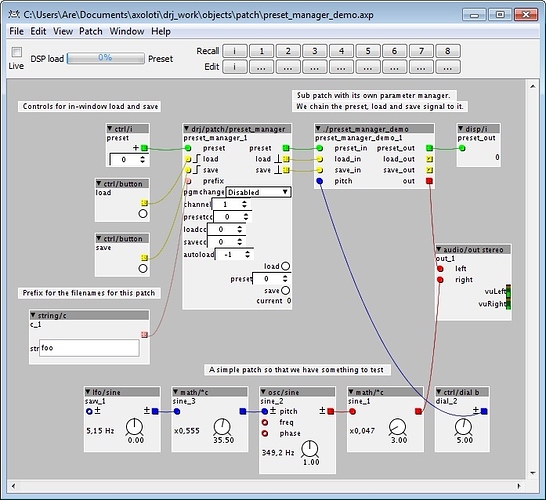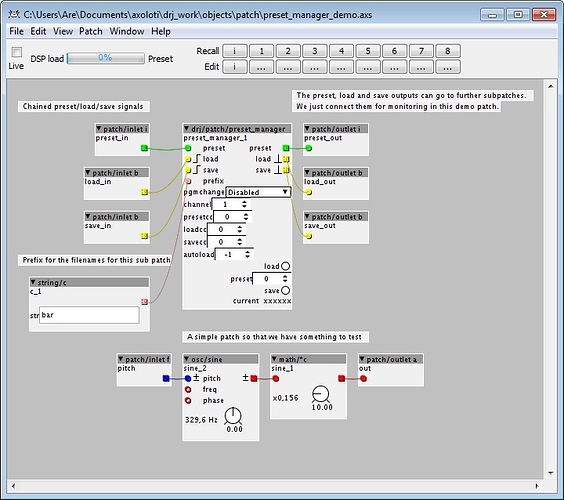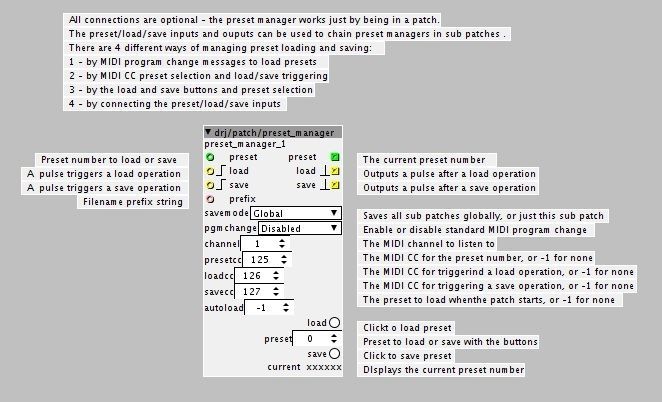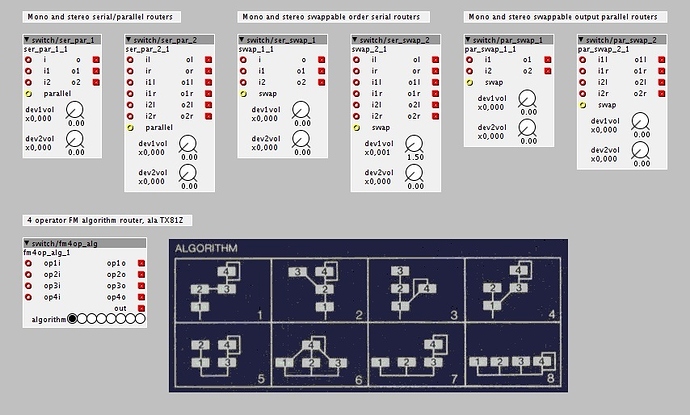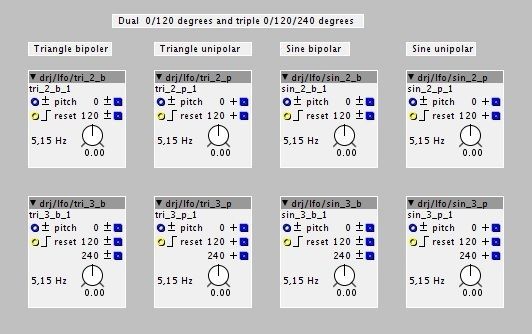Forum profile : @DrJustice
Contributor prefix: drj
objects
drj/audio/out_stero_vol - output with volume control and 12dB gain
drj/audio/deglitcher - audio deglitcher
drj/audio/deglitcher - audio deglitcher with buiult in volume control
drj/audio/stereo_vol - stereo volume control with external volume input
drj/audio/stereo_vol - stereo volume control with volume knob
drj/osc/dual_sine.axo - dual phase sine oscillator, 0 and 90 degrees
drj/osc/quad_sine.axo - quad sine oscillator 0, 90, 180 and 270 degrees
drj/osc/phasor_pm_pr_b - bipolar phasor with phase modulation and phase reset
drj/osc/phasor_pm_pr_p - unipolar phasor with phase modulation and phase reset
drj/osc/phasor_pm_s_b - bipolar phasor with phase modulation and sync
drj/osc/phasor_pm_s_p - unipolar phasor with phase modulation and sync
drj/osc/sine_pm_pr_b - bipolar sine osc with phase modulation and phase reset
drj/osc/sine_pm_pr_p - unipolar sine osc with phase modulation and phase reset
drj/osc/sine_pm_s_b - bipolar sine osc with phase modulation and sync
drj/osc/sine_pm_s_p - unipolar sine osc with phase modulation and sync
drj/lfo/lfo_pwm_b - bipolar pwm lfo
drj/lfo/lfo_pwm_u - unipolar pwm lfo
drj/lfo/sin_ph_b - bipolar sine lfo with phase control
drj/lfo/sin_ph_p - unipolar sine lfo with phase control
drj/lfo/sin_2_b - dual bipolar sine lfo, 0 and 90 degrees
drj/lfo/sin_2_p - dual unipolar sine lfo, 0 and 90 degrees
drj/lfo/sin_4_b - quad bipolar sine lfo, 0 and 90 degrees
drj/lfo/sin_4_p - quad unipolar sine lfo, 0, 90 , 180 and 270 degrees
drj/lfo/tri_b - bipolar triangle lfo
drj/lfo/tri_p - unipolar triangle lfo
drj/lfo/tri_2_b - dual bipolar triangle lfo, 0 and 90 degrees
drj/lfo/tri_2_p - dual unipolar triangle lfo, 0 and 90 degrees
drj/lfo/tri_4_b - quad bipolar triangle lfo, 0 and 90 degrees
drj/lfo/tri_4_p - quad unipolar triangle lfo, 0, 90 , 180 and 270 degrees
drj/lfo/sin_2_b - dual bipolar sine lfo, 0 and 120 degrees
drj/lfo/sin_2_p - dual unipolar sine lfo, 0 and 120 degrees
drj/lfo/sin_3_b - triple bipolar sine lfo, 0, 120 and 240 degrees
drj/lfo/sin_3_p - triple unipolar sine lfo, 0, 120 and 240 degrees
drj/lfo/tri_2_b - dual bipolar triangle lfo, 0 and 120 degrees
drj/lfo/tri_2_p - dual unipolar triangle lfo, 0 and 120 degrees
drj/lfo/tri_3_b - triple bipolar triangle lfo, 0, 120 and 240 degrees
drj/lfo/tri_3_p - triple unipolar triangle lfo, 0, 120 and 240 degrees
drj/lfo/saw_up_b - bipolar rising sawtooth lfo
drj/lfo/saw_up_p - unipolar rising sawtooth lfo
drj/lfo/saw_dn_b - bipolar falling sawtooth lfo
drj/lfo/saw_dn_p - unipolar falling sawtooth lfo
drj/lfo/lfo_sync - multi waveform LFO with midi/clock sync
drj/lfo/multi_wave_sync - selectable waveform, uni/bi -polar, syncable
drj/lfo/multi_wave - selectable waveform, uni/bi -polar
drj/lfo/multi_wave - selectable waveform, uni/bi -polar, modulation
drj/lfo/dual_multi_wave - selectable waveform, uni/bi -polar, quadrature
drj/lfo/dual_multi_wave - selectable waveform, uni/bi -polar, quadrature, modulation
drj/ctrl/dial_pitch - dial with pitch mapped output
drj/ctrl/fadein_xor - fade/difference control
drj/ctrl/fadeout_xor - fade/difference control
drj/delay/read_sync - delay reader with sync and modulation
drj/delay/read_interp_sync - interpolated delay reader with midi/clock sync and modulation
drj/delay/read32_sync - delay reader with sync and modulation, 32 bit
drj/delay/read32_interp_sync - interpolated delay reader with midi/clock sync and modulation, 32 bit
drj/math/> const i - compare to constant integer
drj/math/< const i
drj/math/== const i
drj/math/!= const i
drj/math/glide_fast - a faster glide module
drj/math/keyscaler - keyboard breakpoint sand scale
drj/math/offset_scale_1 - out = offset + (in * scale)
drj/math/offset_scale_2 - out = offset + (in * scale), s-rate
drj/math/mov_avg - moving average, k-rate fractional and integer, and s-rate fractional
drj/math/mov_avg_clk - moving average with clocking, k-rate fractional and integer
drj/midi/clock_rx - MIDI clock and tranport control receiver
drj/midi/clock_tx - MIDI clock and tranport control transmitter
drj/midi/note_tx - note transmitter with live channel control
drj/midi/nrpn_rx_multi - multi output NRPN receiver
drj/midi/nrpn_rx_multi2 - multi parameter, multi output NRPN receiver
drj/midi/nrpn_rx_f - fractional output NRPN receiver
drj/midi/nrpn_rx_i - integer output NRPN receiver
drj/patch/preset_manager.axo - manager for loading and saving presets
drj/seq/clk_div - clock divider
drj/seq/clk_mul - clock multiplier
drj/seq/seq_clk - step sequencer clock controller
drj/seq/seq_clk_sync - step sequencer clock controller with midi/clock sync
drj/seq/pattern_selector - 4 way syncable step sequencer pattern selector
drj/seq/stepseq_4_b - bipolar value * 4 selector
drj/seq/stepseq_4_u - bipolar value * 4 selector
drj/seq/stepseq_4_pitch - bipolar value * 4 selector
drj/seq/stepseq_4_switch - switch * 4 selector
drj/seq/stepseq_8_b
drj/seq/stepseq_8_u
drj/seq/stepseq_8_pitch
drj/seq/stepseq_8_switch
drj/seq/stepseq_16_b
drj/seq/stepseq_16_u
drj/seq/stepseq_16_pitch
drj/seq/stepseq_16_switch
drj/seq/tap_tempo - tap tempo clock generator
drj/switch/ser_par_1 - mono serial/parallel switch
drj/switch/ser_par_2 - stereo serial/parallel switch
drj/switch/ser_swap_1 - mono serial order swapping switch
drj/switch/ser_swap_2 - stereo serial order swapping switch
drj/switch/par_swap_1 - mono parallel output swapping switch
drj/switch/par_swap_2 - stereo parallel output swapping switch
drj/switch/fm4op_alg - router for 4 operator FM synthesis, ala TX81Z
drj/fx/chorus - multi voice chorus, 3 variants
drj/fx/phaser_32_mod - phaser with built in controls and modulation
drj/fx/phaser_32 - phaser with external controls and modulation
drj/file_file_size - outputs the number of 16 bit samples in a named file
patches
drj/delay/delay_st_pp.axs - stereo/ping-pong delay
drj/delay/delay_st_pp_mod.axs - stereo/ping-pong modulation delay
drj/delay/delay_st_pp_sync.axs - stereo/ping-pong midi/clock syncable delay
drj/delay/delay_st_pp_mod_sync.axs - stereo/ping-pong midi/clock syncable modulation delay
drj/fx/stereo_chorus.axs - stereo chorus subpatch
drj/fx/stereo_phaser.axs - stereo phaser subpatch
firmware
none yet

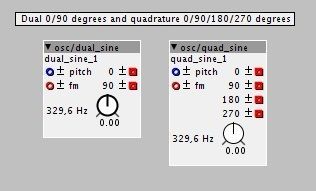

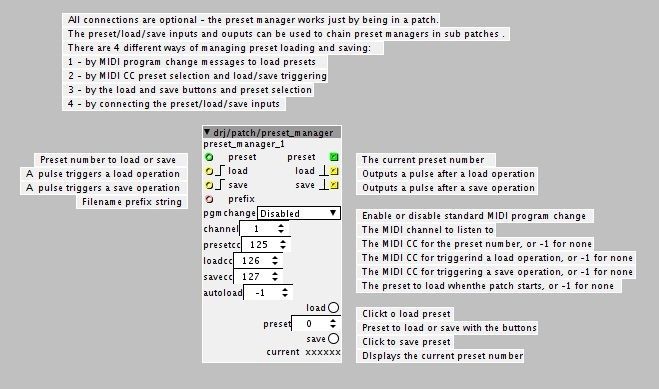
 There have been a lot of talk about how to do this. Cant wait to try it out
There have been a lot of talk about how to do this. Cant wait to try it out 
